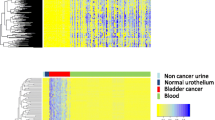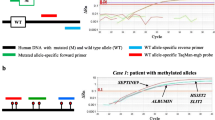Abstract
Background: Bladder cancer shows frequent nonrandom allelic deletion at various chromosomal regions. Genotypic detection methods could potentially identify patients at risk for recurrent progressive disease. In this study, we examined allelic deletion at specific chromosomal loci in tumor tissue and urine cell sediment samples using a microsatellite-based protocol. Although both allelic deletion and microsatellite instability have been reported in primary bladder cancer, microsatellite instability was not specifically examined in this study. We report a pilot study of 40 patients with bladder cancer in which allelic deletion in tumor tissue and urine cell sediment was compared with conventional urine cytology results.
Methods and Results: Forty tumors were analyzed using a set of microsatellite primers from chromosomes 3, 4, 8, 11, 14, and 17 to construct allelic deletion fingerprints. Cy5.5-labeled PCR products were analyzed using the OpenGene System and GeneObjects software. Eighty-eight percent of tumors showed allelic deletion. In urine cell sediments, the tumor detection rate was 80% compared with 50% for routine urine cytology. The allelic deletion fingerprinting (ADF) procedure identified 69% of incipient tumors, cases initially classified as normal by routine urine cytology.
Conclusion: ADF analysis provides a reliable noninvasive method for the detection and monitoring of recurrent cancer in urine cell sediment samples from patients with bladder cancer.
Similar content being viewed by others
References
Nam RK, Redelmeier DA, Spiess PE, Sampson HA, Fradet Y, Jewett MA: Comparison of molecular and conventional strategies for followup of superficial bladder cancer using decision analysis. J Urol 2000; 163:752–757
Boring C, Squiers T, Tong T, Montgomery S: Cancer statistics. Cancer J Clin 1994;44:7–26
Mao L: Genetic alterations as clonal markers for bladder cancer detection in urine. J Cell Biochem 1996;25:191–196
Sidransky D, Von Eschenbach A, Tsai C, et al.: Identification of p53 gene mutations in bladder cancers and urine samples. Science 1991;252:706–709
Rosin M, Cairns P, Epstein J, Schoenberg M, Sidransky D: Partial allelotype of carcinoma in situ of the human bladder. Cancer Res 1995;55:5213–5216
Knowles M, Elder P, Williamson M, Cairns J, Shaw M, Law M: Allelotype of human bladder cancer. Cancer Res 1994;54:531–538
Knowles M: Molecular genetics of bladder cancer. Br J Urol 1995;75:57–66
Kryger JV, Messing E: Bladder cancer screening. Semin Oncol 1996;23:585–597
Loh CS, Spedding AV, Ashworth MT, Kenyon WE, Desmond AD: The value of exfoliative urine cytology in combination with flexible cystoscopy in the diagnosis of recurrent transitional cell carcinoma of the urinary bladder. Br J Urol 1996;77:655–658
Mao L, Schoenberg MP, Scicchitano M, Erozan YS, Schwab D, Sidransky D: Molecular detection ofprimary bladder cancer by microsatellite analysis. Science 1996;271:659–662
World Health Organization: Histological typing of urinary bladder tumours. In WHO: International classification of tumours, no. 10. WHO, Geneva, 1973
Union Internationale Contre le Cancer: TNM Classification of malignant tumours, 3rd ed. UnionInternationale Contre le Cancer, Geneva, 1978, pp 113-117
Spruck C, Ohneseit P, Gonzalez-Zulueta M, et al.: Two molecular pathways to transitional cell carcinoma of the bladder. Cancer Res 1994;54:784–788
Steiner G, Schoenberg M, Linn J, Mao L, Sidransky D: Detection of bladder cancer by microsatellite analysis of urine. Nat Med 1997;3:621–624
Hahn S, Seymour A, Hoque A, et al.: Allelotype of pancreatic adenocarcinoma using xenograft enrichment. Cancer Res 1995;55:4670–4675
Mao L, Lee D, Tockman M, Erozan Y, Askin F, Sidransky D: Microsatellite alterations as clonal markers for the detection of human cancer. Proc Natl Acad Sci U S A 1994;91:9871–9875
Author information
Authors and Affiliations
Corresponding author
Rights and permissions
About this article
Cite this article
Larsson, P.C.M., Beheshti, B., Sampson, H.A. et al. Allelic Deletion Fingerprinting of Urine Cell Sediments in Bladder Cancer. Molecular Diagnosis 6, 181–188 (2001). https://doi.org/10.1007/BF03262051
Received:
Revised:
Accepted:
Published:
Issue Date:
DOI: https://doi.org/10.1007/BF03262051




